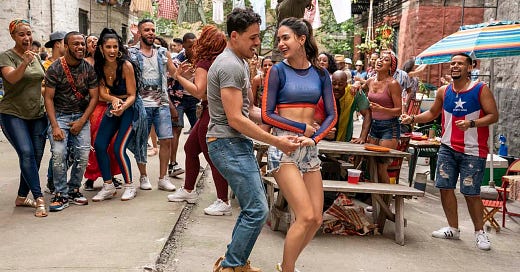Lin-Manuel Miranda’s Broadway and West End sensation Hamilton artfully combines hip hop, R&B, soul and the history of the founding of the United States. Geography students, however, would do better to enjoy the film adaptation of Miranda’s stage musical In the Heights. Hamilton tells the story of ‘great men’ shaping history, In the Heights tells the story of ordinary people shaping places.
In the Heights is set in Washington Heights, New York. The area, like much of New York, has a long history as a home to immigrants with many middle-class Irish and Eastern European residents in the mid-twentieth century. Throughout the 1960s and 70s the proportion of black and latino residents increased sparking ‘white flight’ as white residents left for the suburbs. Meanwhile, emigration from the Dominican Republic spiked sharply. By the 2020 census those recorded as Hispanic or Latino were 64.1% (92,279) of the population. In the Heights’s lead character, Usnavi, ‘immigrated from the single greatest little place in the Caribbean; Dominican Republic!’
With a relatively poor population in the late twentieth-century, low rents and a good location close to downtown New York, Washington Heights was almost perfect for gentrification. However, it didn’t start in the 1980s and early 1990s as the area suffered a crime epidemic linked to its high levels of poverty and unemployment. In 1989 the New York Times called the neighbourhood ‘the crack (cocaine) capital of America’. From the mid-1990s a combination of community activism, new police tactics and wider social trends prompted a dramatic fall in Washington Heights crime rate. Between 1990 and 2021 thefts, murders and robberies all fell by over 75%. Washington Heights really was now ready to be gentrified.
The usual symptoms that it is happening include rent increases, changing demographics and changes to the provisions of services as wealthier residents with different tastes move in. The New York University Furman Center found that Washington Height’s average residential rent had increased by 29.3% between 1990 and 2014. Rent increases mean many shops and services catering to the local population have been priced out. Coogan’s, a well-known restaurant and bar, nearly suffered a similar fate until an outcry by many locals, including Lin-Manuel Miranda, supported it in renegotiating its rent. Demographic changes have also occurred as the previous ‘white flight’ has reversed. Between 2000 and 2020, the white population increased by 42%, while the black and Hispanic/Latino populations decreased by 26% and 25% respectively.
The brilliance of Miranda’s In the Heights is the voice he gives to those communities in Washington Heights on the receiving end of gentrification. The film starts with Usnavi narrating the impacts of gentrification on his neighbourhood,
Times are tough on this bodega [corner shop],
two months ago somebody bought Ortega’s [another shop]
our neighbourhood’s started packin’ up and pickin’ up and
ever since the rents went up,
it’s gotten mad expensive, but we live with just enough.
Later, as the neighbourhood is plunged into a power cut in the sweltering summer the community sing of their predicament. They are powerless. Both literally and metaphorically in their struggle against gentrification. During the power cut the cast sing:
[If] We close the bodega
the neighbourhood is gone!
They selling the dispatch [taxi cab company]
and they closing the salon.
And they’ll never turn the lights back on, ‘cause
we are powerless, we are powerless!




